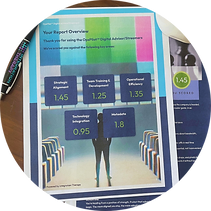AI Is Not the Problem. Your Workflow Might Be.
- Rebecca Avery
- Mar 24
- 3 min read
Summary: The media industry is in the middle of an AI revolution. But many organizations are experiencing friction, not progress. This article unpacks why operational foundations matter more than ever and how leaders can take practical steps to avoid burnout, bottlenecks, and brand damage.

From content creation to audience targeting to automation in production, the promise of AI is everywhere. The headlines are exciting, and the demos are impressive. But if you peel back the hype, the reality for most teams looks very different.
The pressure to innovate is high. But the readiness to support that innovation is low.
Behind every “AI-powered” breakthrough, someone in operations is quietly pulling extra shifts to fix what automation broke.
The technology is real. The risk is also real. Not because AI is bad, but because it is being bolted onto workflows that were never built for this level of speed or complexity.
Where the system starts to crack
Here is what I am seeing inside real media organizations.
AI is being deployed to tag content, localize assets, streamline versioning, and improve delivery timelines. But without connected systems and clean data, these tools cause more confusion than clarity.
Teams are spending hours chasing metadata errors and correcting rights violations. Decision makers are acting on flawed reports. Creative work is being rushed through compliance without proper checks.
People are tired. And trust in the process is wearing thin.
This is not a failure of technology. It is a failure of infrastructure and alignment.
What success looks like in practice
Some companies are starting to figure this out.
At A+E Networks, leadership made the decision to rework the company’s entire operations environment. They moved to a cloud-based infrastructure and internalized key media workflows with the Polaris platform. Instead of rushing to adopt AI, they prioritized automation that worked in sync with editorial, compliance, and delivery.
On the sports side, a recent Grand Slam tennis tournament used AI to analyze nearly five hundred hours of live footage. The system identified emotional reactions, key plays, and moments of tension, generating more than three hundred hours of highlight content. This reduced manual editing by seventy percent and cut costs by eighty percent.
Both efforts delivered results. But they only worked because leaders committed to changing how the work was done before they asked machines to do more of it.
That is the real lesson. Innovation that is not grounded in operational design will not scale. It will strain.
A better way forward
If your organization is wrestling with these challenges, there are five things to focus on.
First, treat metadata as infrastructure. Without consistent, accurate, and shared data, AI cannot make good decisions. Metadata quality is the bedrock of every workflow you want to automate.
Second, stop thinking about AI as an overlay. Instead, design your workflows to expect it. Every process, every approval path, every handoff should function whether the next action is taken by a human or a machine.
Third, assign ownership. Not everything can be automated. Make sure your team knows who is responsible for spotting issues, correcting them, and learning from mistakes. Ambiguity slows everything down.
Fourth, make AI a cross-functional conversation. Legal, ops, content, and technology must be at the same table from day one. If AI is only being evaluated by engineering, the blind spots will grow quickly.
Finally, begin with what is broken. The best place to start using AI is wherever your people are already overwhelmed. Use the pressure point as your first use case. Then build from there.
This is not a tech story. It is a trust story.
AI cannot fix misaligned teams. It cannot solve unclear processes. It cannot repair broken data.
But when these things are addressed, AI becomes a real force multiplier.
The organizations that thrive in this era will not be the ones chasing the newest tools.
They will be the ones building stable systems that support bold ideas.
If your team feels the pressure to move faster, stop and ask whether your foundation can carry the weight.
The future is not about how much AI you use. It is about how well your systems can handle change.




.png)